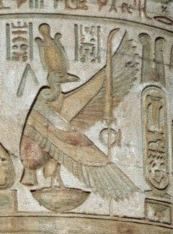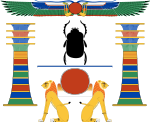奈赫贝特
| 奈赫贝特 | |||||||
|---|---|---|---|---|---|---|---|
 奈赫貝特的圖像,為一隻頭戴阿特夫冠,腳抓繩環和羽毛權杖的展翅禿鷹 | |||||||
| 圣书体名稱 |
| ||||||
| 祭祀中心 | 尼可布 | ||||||
| 符号与象徵 | 禿鷹 | ||||||
| 性别 | 女 | ||||||
涅赫贝特(Nekhbet)(/ˈnɛkˌbɛt/;[1]也被拼写为 Nekhebit)是埃及神话中早期前王朝时期尼可布(Nekheb)城的守护神,她的名字意思就是“尼可布的”。最终,成为了上埃及的守护神,也是古埃及统一后的二个保护神之一[2]。

神话
[编辑]埃及最古老的神谕所是在尼可布的涅赫贝特寺庙,原大墓地或死城。是尼肯(Nekhen,希腊语:希拉孔波利斯)的伴城,上埃及史前末期(公元前3200年-公元前3100年)或也可能是早王朝时期(公元前3100-公元前2686年)的宗教和政治首都[2]。涅赫贝特遗址上的原始村落可追溯至奈加代(Naqada)一期或晚期巴达里文化(Badarian cultures)。约在公元前3400年,希拉孔波利斯至少有5000,甚至多达10000名居民。
涅赫贝特的女祭司被称为“姆乌”(muu,母亲),身穿埃及秃鹫羽毛长袍。
涅赫贝特是上埃及守护神,她与下埃及守护神瓦吉特(Wadjet)经常作为“双女”(Two Ladies)一道出现。其中每一位统治者的称号是名字“Nebty”,以“双女...”的象形文字开头[2]。
在艺术作品上涅赫贝特被描绘成一只秃鹰。艾伦·加德纳(Alan Gardiner)辨认出神像中的秃鹫像一只兀鹫。然而,阿里尔.P.科兹洛夫(Arielle P. Kozloff)却认为,新王国时期艺术品中的秃鹫,有蓝色的尖喙和松弛的皮肤,更像肉垂秃鹰[3]
在新王国时期,秃鹫总是与头饰上乌赖乌斯(uraeus,法老头饰上的蛇形标记)并列出现,而国王却被隐去。乌赖乌斯和秃鹫的传统解释是瓦吉特和涅赫贝特,但是埃德娜.拉斯曼(Edna R. Russmann)认为,在此背景下,它们分别代表两位亡灵守护女神,伊希斯(Isis)和奈芙蒂斯(Nephthys)[4]
涅赫贝特通常被画成张开翅膀,盘旋于帝王头上,很多时候她的爪子抓着一个“生”(shen)环(代表无穷、“所有”或“一切”)[2],作为法老的守护神。有时,她被视为法老的神母,在这个方面,她是“母亲的母亲”,“尼可布的白色大母牛” 。
在部分晚期的亡灵书中涅赫贝特被称为“父亲的父亲”、“母亲的母亲”,从开始就已存在,并是这个世界的女性创造者。
参考文献
[编辑]- Hans Bonnet: Nechbet. In: Lexikon der ägyptischen Religionsgeschichte. Nikol, Hamburg 2000, ISBN 3-937872-08-6, S. 507f.
- Wolfgang Helck, Eberhard Otto: Nechbet. In: Kleines Lexikon der Ägyptologie. Harrassowitz, Wiesbaden 1999, ISBN 3-447-04027-0, S. 199.
- Alexandra von Lieven: Grundriss des Laufes der Sterne – Das sogenannte Nutbuch. The Carsten Niebuhr Institute of Ancient Eastern Studies (u. a.), Kopenhagen 2007, ISBN 978-87-635-0406-5.
- Alexandra von Lieven: Der Himmel über Esna – Eine Fallstudie zur religiösen Astronomie in Ägypten am Beispiel der kosmologischen Decken- und Architravinschriften im Tempel von Esna. Harrassowitz, Wiesbaden 2000, ISBN 3-447-04324-5.
- M. Werbrouck: Fouilles de El Kab II. 1940, S. 46ff.
| ||||||||||||||||||||||||||||||||||||||||||||||||||||||||||||
Text is available under the CC BY-SA 4.0 license; additional terms may apply.
Images, videos and audio are available under their respective licenses.

